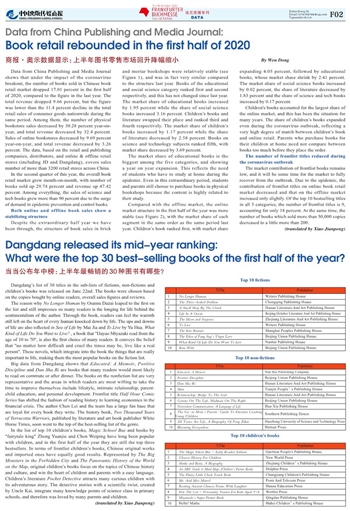By Wen Dong
Data from China Publishing and Media Journal shows that under the impact of the coronavirus breakout, the number of books sold in Chinese book retail market dropped 17.01 percent in the frst half of 2020, compared to the fgure in the last year. The total revenue dropped 9.66 percent, but the figure was lower than the 11.4 percent decline in the total retail sales of consumer goods nationwide during the same period. Among them, the number of physical bookstore sales decreased by 30.28 percent year-on-year, and total revenue decreased by 32.4 percent. Sales of online bookstores decreased by 9.69 percent year-on-year, and total revenue decreased by 3.26 percent. The data, based on the retail and publishing companies, distributors, and online & offline retail stores (including JD and Dangdang), covers sales number of more than 3200 retail stores across China.
In the second quarter of this year, the overall book retail market grew month-on-month, with number of books sold up 29.74 percent and revenue up 47.42 percent. Among everything, the sales of science and tech books grew more than 90 percent due to the surge of demand in epidemic prevention and control books.
Both online and offline book sales show a stabilizing structure
Despite the extraordinary half year we have been through, the structure of book sales in brick and mortar bookshops were relatively stable (see Figure 1), and was in fact very similar compared to the structure last year. Books of the educational and social science category ranked first and second respectively, and this has not changed since last year. The market share of educational books increased by 1.95 percent while the share of social science books increased 3.16 percent. Children’s books and literature swapped their place and ranked third and fourth respectively. The market share of children’s books increased by 1.17 percent while the share of literature decreased by 2.58 percent. Books on science and technology subjects ranked fifth, with market share decreased by 3.69 percent.
The market share of educational books is the biggest among the five categories, and showing a year on year expansion. This reflects the need of students who have to study at home during the epidemic. Even in this extraordinary period, students and parents still choose to purchase books in physical bookshops because the content is highly related to their study.
Compared with the offline market, the online market structure in the frst half of the year was more stable (see Figure 2), with the market share of each segment in the same order as the same period last year. Children’s book ranked frst, with market share expanding 4.05 percent, followed by educational books, whose market share shrink by 2.41 percent. The market share of social science books increased by 0.02 percent, the share of literature decreased by 1.83 percent and the share of science and tech books increased by 0.17 percent.
Children's books accounted for the largest share of the online market, and this has been the situation for many years. The share of children’s books expanded even during the coronavirus outbreak, reflecting a very high degree of match between children’s book and online retail. Parents who purchase books for their children at home need not compare between books too much before they place the order.
The number of frontlist titles reduced during the coronavirus outbreak
The market contribution of frontlist books remains low, and it will be some time for the market to fully recover from the outbreak. Due to the epidemic, the contribution of frontlist titles on online book retail market decreased and that on the offline market increased only slightly. Of the top 10 bestselling titles in all 5 categories, the number of frontlist titles is 9, accounting for only 18 percent. At the same time, the number of books which sold more than 50,000 copies decreased to a little more than 200.
(translated by Xiao Jianpeng)


